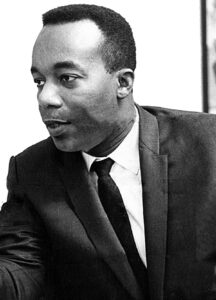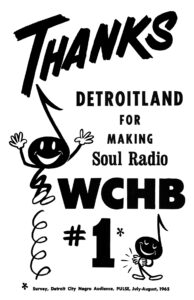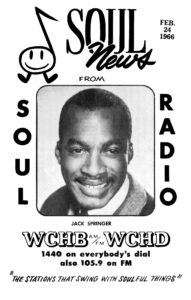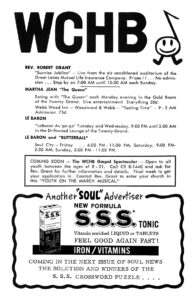 WCHB Jumps Evening Slot To Number One Status In Detroit
WCHB Jumps Evening Slot To Number One Status In Detroit
NEW YORK — R&B radio stations are having a banner year and many have turned into powerhouses in the general market. For example, WCHB in Detroit is No. 3 during the daytime in the general market and after 6 p.m. goes to No. 1. The ratings success story of WOL in Washington in the past year has been the talk of the radio industry.

All over the nation, modern R&B stations in general are doing great and program directors point to two factors as having an influence on this – the growing popularity of R&B music among whites as well as Negroes, plus the up-dating of the programming and production at these stations.
Bill Curtis, program director of WCHB, Detroit, said, “This station has been building up over the past few years. It’s owned by two Negro doctors who’ve been extremely involved in community affairs, so people look to us as, leaders in the community.
“Too, our sound is as good or better as any station in town. We have strong deejays: Bill Williams is one of the best in the country, a top 40 type personality. And we have Martha Jean Steinberg. All of our personalities are just as smooth, as competent as any jockey on any station.”
Like other program directors, Curtis felt the overall status of the R&B deejay had made tremendous progress in the past year. And one reason why they have achieved status in the community, he said. “is that in the old days the stereotyped R&B deejay said anything that came into his mind. It often offended people or was distasteful. Today, with modern production and tight programming, the deejays only have time for news, temperature, announcing the time, and playing records. There is very little time left in which to say something wrong.”
 KYOK in Houston is another station that’s achieving success. Program director Al Garner said that R&B radio “period” is looking better in Houston. Sitting in for vacationing deejays during the past few weeks, Garner said he noticed that his station was picking up a growing number of Latin American listeners, as well as white kids. The station runs third and fourth now in the general market, he said, and competes on the general market level for advertising.
KYOK in Houston is another station that’s achieving success. Program director Al Garner said that R&B radio “period” is looking better in Houston. Sitting in for vacationing deejays during the past few weeks, Garner said he noticed that his station was picking up a growing number of Latin American listeners, as well as white kids. The station runs third and fourth now in the general market, he said, and competes on the general market level for advertising.
Lucky Cordell, program director of WVON in Chicago, said the status of Chicago R&B deejays, at least, was improving. “E. Rodney Jones and Pervis Spann own a nightclub. Herb Kent has just opened a ballroom for record hops. It’s now a prestige factor to be an R&B deejay. Deejays are respected in the community.”

He tied in the success of R&B stations in the past few months with the civil rights movement — “We’ve become more and and more a source of information. We’ve doing a much better job of reporting the news that involves Negroes than the other stations in now. Whereas R&B stations used to be mostly for the kids, this is no longer true.”
The station, he said, helped “a good deal” in settling the people down during a recent flare-up.” George Wilson, program director of WHAT in Philadelphia, said there’s no question about the status of the R&B deejay improving. The National Association of Radio Announcers, he said, had helped enormously. “There’s a growing substance to the organization and it’s making an influence. “Nowadays, the successful R&B DJ assume a role of leadership that we didn’t before. We must assume the responsibility of uplifting the kids.”
 WDIA in Memphis sets in an enviable position; it has been No. 1 in the market for about 17 years, said program director Bob McDowell, largely through community involvement. The station supports 145 baseball teams with equipment, provides two buses to take crippled children to school daily, supports school for crippled children, plus other good-will projects.
WDIA in Memphis sets in an enviable position; it has been No. 1 in the market for about 17 years, said program director Bob McDowell, largely through community involvement. The station supports 145 baseball teams with equipment, provides two buses to take crippled children to school daily, supports school for crippled children, plus other good-will projects.
McDowell, a recording artist for Fame Productions, said he felt the status of R&B deejays had definitely improved. “I can tell by the quality of the men who’ve come here in the past three years; they’re good, high quality personalities which is one reason why we’re on top.” The popularity of R&B music is growing, he said, “even here,” considered to be one of the leading R&B centers of the nation. END
_______________
Credit source information (as published): Billboard, August 13, 1966

![]()

